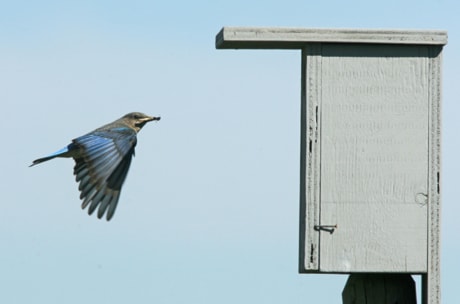The victims of disaster stared back at its discoverers in mute horror.
Across a large area of Alberta last year, a spring blizzard followed by more than a week of cold weather had devastated the hundreds of male bluebirds that had flown north to prepare nests.
Their stricken bodies were found lying in groups on the floors of the wooden boxes that became their coffins.
“On April 18, the blizzard hit and it didn’t warm up until April 25th,” says biologist Myrna Pearman, site services manager for the Ellis Bird Farm, east of Blackfalds.
“There were nights when the temperature was -11, but the wind chill hovered at about -20 and daytime temperatures were freezing.
“The bluebirds had arrived toward the end of March and were just getting nicely settled and succumbed to the elements — starvation and hypothermia, a combination.”
Right around the Ellis farm, it had looked like numbers were on an upward trend. After the storm, the farm ended up with 28 pairs from 60 the year before.
A number of those surviving nests appeared occupied by females and chicks only, with no males in sight, said Pearman.
“More males were killed than females. We’re not sure why.”
All of the dead birds found in boxes were males, and they were all in groups.
“Whether they didn’t allow the females to come in, or whether the females headed south, I don’t know.”
Jim Potter at Delburne found a group of dead males huddled together in one of his duck boxes, said Pearman.
It wasn’t until last fall that she and fellow bluebird area managers realized the full extent of the storm’s damage. Losses in an area cutting across the central regions of the province averaged 40 to 50 per cent.
What had been a healthy bluebird population at Provost nearly disappeared. The person who manages the bluebird area there counted only 78 birds fledged that fall. She normally sees 700 to 800.
As expected, the numbers are down at the Ellis Bird Farm this year, and are actually less than what Charlie Ellis had when he and Winnie were still running their program.
To be fair, the areas around the farm do not provide the best bluebird habitat, says Pearman. The species does not cope well with cultivated land and the influx of small acreages has brought with it an increase in house sparrows, a non-native species that competes with bluebirds for food and territory.
Ironically, the drought that has left so many livestock and grain producers pondering their future has been beneficial to those bluebirds that have returned to the farm, says Pearman.
There are plenty of insects to eat and the bluebirds that came back to nest this year have already fledged their first hatch and are now laying again.
Pearman hopes the second round of nestlings will make a significant difference in the number of bluebirds that make it back for the 2010 season.
Tempering the promise of a rebound in bluebird numbers is increased competition from tree swallows, says Pearman.
“The last few years have been perfect conditions for tree swallows, so their numbers have increased dramatically.”
Last year, when the bluebirds were killed off, tree swallows moved into the boxes. Bluebirds moving back to the boxes this year have found themselves doing battle with tree swallows, which in many cases are able to drive the bluebirds away, even when they have already started nesting.
Tree swallows also seem to be becoming more tolerant of each other, so putting two boxes in close proximity, hoping the bluebirds would get into one of them, isn’t working as well as it should.
“I’ve seen tree swallows in both boxes,” says Pearman.
It will be a few more weeks before bluebird area managers can measure if and how well the bluebirds populations have recovered from last year’s storm, she says.
One of the questions arising from last year’s disaster is whether or not the surviving males are the genetically fit to propagate the species. Did the storm wipe out the males that were first to arrive and claim breeding territory?
Those are questions Pearman says she has pondered, but cannot answer.
Area managers do what they can to make their bluebirds comfortable while they’re here, says Pearman. Ultimately, the fate of the species is out of their control.
“We don’t have any control over the weather or what happens on migration or in their wintering grounds. So, we could have a bumper crops here and they could be affected by bad weather or other calamities in their wintering grounds, or they could be devastated by spring storms on their way back.”
bkossowan@www.reddeeradvocate.com
